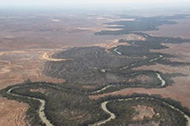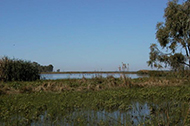Priorities Action Statement - Actions for Lowland Lachlan River Aquatic Endangered Ecological Community
 Lachlan River
Lachlan River
© Department of Natural Resources
 Blindbungi
Blindbungi
© Department of Natural Resources
Recovery Actions
Advice to consent and determining authorities
- Provide local councils, government agencies and Local Land Service's (LLS's) with resource materials and training regarding habitat protection and threatened species provisions of the NSW Fisheries Management Act 1994 to support planning, determination, impact assessment and concurrence decision making processes. This may include impact assessment guidelines, mitigating prescriptions, offsets, and generic consent conditions (Medium priority).
- Distribute guidelines regarding flow requirements of key characteristic species to relevant Natural Resource Management (NRM) agencies (Medium priority).
Collate and review existing information
- Compile existing records of characteristic native species occupying the Endangered Ecological Community (EEC) and map their current known distribution (High priority).
Community and stakeholder liaison, awareness and education
- Develop and disseminate advisory materials on priority issues relevant to the recovery of the EEC (Low priority).
- Improve community awareness of the threats facing the EEC through regular dissemination of advisory information, through the media, existing networks and newsletters (Low priority).
- Encourage community reporting of key species through the Protected, Threatened and Pest Species Sighting Sheet Program (Low priority).
- Actively encourage community involvement in aspects of the recovery of the EEC including for example, research, reporting, monitoring and management activities (Low priority).
Compliance / enforcement
- Implement and enforce relevant fishing regulations (e.g. seasonal closures, bag and size limits, gear restrictions etc.) (High priority).
- Undertake and continue targeted enforcement activities by regional Fisheries Officers (High priority).
- Identify and implement measures to improve the reporting of illegal activities and enhance feedback to stakeholders (such as anglers) on actions taken (High priority).
- Investigate options and implement measures to improve the reporting of illegal activities and enhance feedback to anglers on compliance and regulatory actions taken (High priority).
Enhance, modify or implement NRM planning processes to minimize adverse impacts on threatened species
- Ensure that information on the location of characteristic native species within the EEC is considered in state and national management programs for introduced species and diseases (Medium priority).
Habitat protection
- Review regulatory and voluntary incentive based mechanisms available in the EEC to enhance protection for key habitat areas and apply as required. This may include the use of critical habitat provisions, aquatic reserves, environmentally sensitive land provisions, voluntary conservation agreements etc (Medium priority).
Habitat rehabilitation
- Identify and prioritise the most significant barriers to fish passage within the geographic area of the EEC having regard to relevant existing programs (Medium priority).
- Work with LLS's to encourage implementation of relevant aquatic habitat rehabilitation / threatened species actions outlines in catchment action plans (Medium priority).
- Determine key threatening processes within each zone and prioritise zones for action according to management capability, ecological function and threatened species considerations (Medium priority).
- Advocate appropriate allocation and improved management of environmental flows, particularly in areas known to support remnant natural populations of threatened species and reduced diversion volumes during the spawning and larval period (Medium priority).
- Improve fish passage at major regulating structures through existing programs (Medium priority).
- Work with local councils and relevant government agencies to mitigate the impacts of cold water pollution within the EEC (Medium priority).
- Develop a NSW Cold Water Pollution Program including a program of works and funding options (Medium priority).
- Support and assist community groups, NRM authorities, local councils and landholders to protect and rehabilitate riparian vegetation and instream habitats along key river reaches where populations of threatened species are known to occur (Medium priority).
- Develop new projects in consultation with community groups, relevant natural resource management agencies, local councils and landholders to address key water quality issues within the EEC (e.g. sedimentation, algal blooms, salinity, and agricultural chemicals) (Medium priority).
Pest eradication and control
- Assess information on current management techniques for pest species and their application in the EEC (Medium priority).
- Reduce the risk of disease and pest species introduction from aquaculture operations by ensuring compliance with the Hatchery Quality Assurance Program and appropriate grow-out facility permit conditions (Medium priority).
- Monitor populations of introduced fish species at key sites and undertake eradication and/or control programs where appropriate (Medium priority).
Research / monitoring
- Develop and implement a targeted investigation program to quantify the distribution and abundance of native species in the EEC, focusing on threatened species and populations. The investigation program should form the basis for monitoring over time (High priority).
- Develop and implement research projects investigating key areas of the biology and ecology of characteristic native species within the EEC to inform the recovery program. Projects are to include for example, investigation into flow requirements, taxonomic status, levels of genetic diversity, migration, habitat requirements, factors critical to the successful spawning and recruitment, interactions between trophic guilds, interactions with introduced species and environmental tolerances (High priority).
- Investigate the impacts of water diversion on fish larvae (High priority).
- Develop guidelines and principles to help determine the ecological needs of key characteristic species within the EEC and the flow levels required to complete their lifecycle (High priority).
- Investigate the contribution of smaller impoundments (e.g. weir pools) to reductions in river temperatures, and low-cost options for their management (High priority).
- Develop and implement a research program to investigate the impacts of introduced species and diseases that affect native species occupying the EEC, and assess their potential impacts (High priority).
- Investigate available evidence on the impacts of commercial and recreational fishing activities on key native species in the EEC (High priority).
- Develop reference criteria for each river management zone to allow meaningful insights into ecological condition and changes over time to be made (High priority).
- Review the available evidence on the impacts of fishing activities on characteristic native species within the EEC, and the current fishing regulations to determine the need for changes (High priority).
- Design and implement targeted monitoring programs linked to river management zones to enable the effectiveness of recovery actions to be evaluated (High priority).
- Disseminate results from investigation and research activities to inform recovery and threat abatement efforts for threatened species and populations in the EEC (Medium priority).
- Identify the characteristic native species likely to be sensitive to cold water pollution and the extent of instream habitat affected (Medium priority).
- Identify opportunities for collaboration on monitoring and evaluation activities in the EEC (Medium priority).
Stocking / translocation
- Implement the NSW Hatchery Quality Assurance Program and the NSW Freshwater Fish Stocking Fishery Management Strategy to ensure that harvest and conservation stocking activities are carried out in a manner that will not adversely impact wild populations of native fish (High priority).
- Where appropriate enhance and/or initiate conservation stocking programs for threatened species within the ECC (Medium priority).
Survey / mapping
- Develop mapping products for stakeholders regarding the distribution and abundance of native species in the EEC to assist in targeting habitat rehabilitation projects (High priority).
- Establish a system of distinct river management zones for the EEC, consistent with other strategies and plans (where possible), in conjunction with stakeholders including LLS's and natural resource management agencies (Medium priority).




